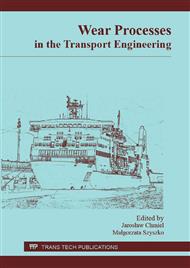[1]
Verein der Kohlenimporteure, Jahresbericht (2015) at: www. kohlenimporteure. de.
Google Scholar
[2]
http: /www. statista. com/statistics/264016/global-seaborne-trade-of-iron-ore-since-(1985).
Google Scholar
[3]
Statistical Yearbook of the Republic of Poland, (2013), Year LXXIII Warsaw. www. stat. gov. pl.
Google Scholar
[4]
R. Leśmian-Kordas (editor): Metody oceny jakości i bezpieczeństwa ładunków w transporcie morskim, Akademia Morska, Szczecin, (2006), p.298.
Google Scholar
[5]
C.K. Man, M.L. Harris: Participation of large particles in coal dust explosions, Journal of Loss Prevention in the Process Industries 27 (2014) pp.49-54.
DOI: 10.1016/j.jlp.2013.11.004
Google Scholar
[6]
T.K. Rout T.K. et al.: Dust fall and elemental flux in a coal mining area, Journal of Geochemical Exploration 144 (2014) 443-455.
DOI: 10.1016/j.gexplo.2014.04.003
Google Scholar
[7]
B. Křibek et al.: Impacts of mining and mineral processing on the environment and human health in Africa, Journal of Geochemical Exploration 144 (2014) 387-390.
DOI: 10.1016/j.gexplo.2014.07.018
Google Scholar
[8]
Z. Xi et al.: Controlling the coal dust at transshipment point: A study of the foam-sol foaming device International Journal of Mining Science and Technology 24 (2014) 625-630.
DOI: 10.1016/j.ijmst.2014.03.031
Google Scholar
[9]
Y. Xie et al.: New Respirable Dust Suppression Systems for Coal Mines Journal of China University of Mining & Technology, (2007), vol. 17, No. 3., pp.321-325. doi: 10. 1016/S1006-1266(07)60097-2.
DOI: 10.1016/s1006-1266(07)60097-2
Google Scholar
[10]
J. S. Chapman, V.A. Ruckley: Microanalysis of lesions and lymph nodes from coal miners' lungs. Br. J. Ind. Med., (1985), 42: 551–555.
DOI: 10.1136/oem.42.8.551
Google Scholar
[11]
N.K. Fred: Handbook for Dust Control in Mining Pittsburg: US Department for Health and Human Service, (2003).
Google Scholar
[12]
J. Chmiel, B. Drzewieniecka et al.: Problemy zużycia taśm przenośnikowych w transporcie nasion roślin oleistych, Problemy eksploatacji nr 4 (2010) (79) s. 207-214, ISSN 1232-9312.
Google Scholar
[13]
B. Wiśniewski, T. Wolski, Hydrometeorologiczne uwarunkowania pracy portu w Szczecinie, Marine Science 5. Nr 243, (1988), pp.7-23.
Google Scholar
[14]
Z. Lawrowski : Tarcie, zużycie i smarowanie – Tribologia, Oficyna Wydawnictwa Politechniki Wrocławskiej, Wrocław, (2008).
Google Scholar
[15]
M. Hebda ,A. Wachał.: Trybologia, Wydawnictwo Naukowo-Techniczne, Warszawa, (1980).
Google Scholar
[16]
K. Górny, P. Tyczewski P., W. Zwierzycki: Specification of lubricating oil operation in refrigeration compressors, Tribologia, 3 (2010), s. 63-73.
Google Scholar
[17]
A. Stachowiak, W. Zwierzycki,: An Analysis of the Tribocorrosion Wear by Means of Wear Maps, Solid State Phenomena, Vol. 225, pp.93-99, Dec. (2014).
DOI: 10.4028/www.scientific.net/ssp.225.93
Google Scholar
[18]
P. Tyczewski, Tribological Wear in the Complex Service Conditions, Solid State Phenomena, Vol. 225, pp.101-108, Dec. (2014).
DOI: 10.4028/www.scientific.net/ssp.225.101
Google Scholar
[19]
S. M. Beloglazov, G. S. Beloglazov,: Electrochemical Hydrogen in Metals - Can we Effectively Control this Harm?, Solid State Phenomena, Vol. 225, pp.1-6, Dec. (2014).
DOI: 10.4028/www.scientific.net/ssp.225.1
Google Scholar
[20]
J. Toribio, V. Kharin, D. Vergara, M. Lorenzo, Hydrogen Diffusion in Metals Assisted by Stress: 2D Numerical Modelling and Analysis of Directionality , Solid State Phenomena, Vol. 225, pp.33-38, Dec. (2014).
DOI: 10.4028/www.scientific.net/ssp.225.33
Google Scholar
[21]
J. Toribio, V. Kharin, A Critical Review of Existing Hydrogen Diffusion Models Accounting for Different Physical Variables, Solid State Phenomena, Vol. 225, pp.13-18, Dec. (2014).
DOI: 10.4028/www.scientific.net/ssp.225.13
Google Scholar
[22]
H. M. Nykyforchyn, O. Z. Student: Influence of Hydrogen on the Formation of Fatigue Thresholds in Structural Steels, Materials Science March (2001), Vol. 37, No. 2, pp.252-263.
Google Scholar
[23]
V.M. Pustovoi, I.O. Reshchenko: Modeling of the in-service degradation of steels of cargo seaport structures under the laboratory conditions, Materials Science, (2013) vol. 48 No. 5. p.561–568.
DOI: 10.1007/s11003-013-9538-x
Google Scholar
[24]
A.I. Balitskii, I. Ripey, J. Chmiel: Deposit Attack In Tubes Of Power Plant Steam Boilers, Problemy eksploatacji, nr 4 (2010) (79) s. 79-90 ISSN 1232-9312.
Google Scholar


